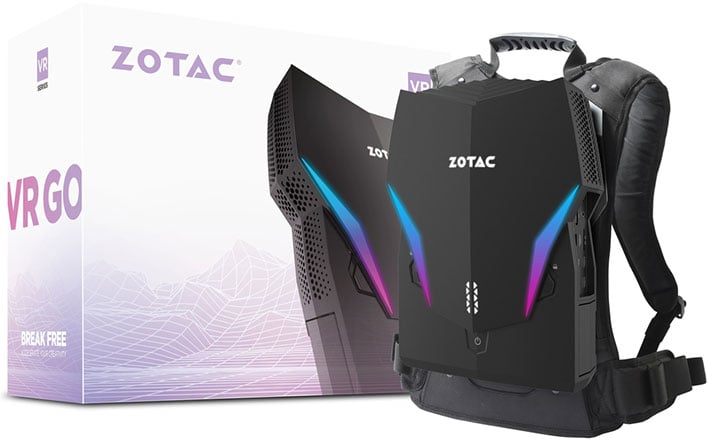Zotac VR Go 4.0 Straps A Core i7 11800H And An RTX A4500 To Your Back

You may have lugged around a backpack with a laptop inside, but what if the backpack was the PC? That's the idea behind Zotac's VR GO, a wearable PC that's again been upgraded. The latest iteration—VR GO 4.0—packs an 11th Gen Intel Core mobile processor paired with discrete NVIDIA RTX graphics, though interestingly Zotac made the switch to a workstation GPU.
On the CPU side, the 4.0 release wrangles a Core i7-11800H processor based on Tiger Lake. While not as fancy as Intel's latest generation Alder Lake lineup, it's still a rather stout 8-core/16-thread CPU with a 2.3GHz base clock, 4.6GHz turbo frequency, and 24MB of L3 cache. We imagine an Alder Lake overhaul is in the works, as the mix of P-core and E-cores seems especially well sorted for this kind of thing.
For graphics, Zotac pivoted from consumer GeForce card to an RTX A4500 with 20GB of GDDR6 memory tied to a 320-bit memory bus (Zotac's spec sheet lists it as having 16GB of GDDR6 and a 256-bit bus, but those are apparent typos). That's a workstation GPU. Why the switch? It seems that in addition to pushing VR gaming, Zotac wants to also attract developers and 3D designers with the latest iteration of the VR GO.
The pitch here is that you can wear a powerful PC on your back and plug in a VR headset that isn't wireless (or one that can optionally be connected to a PC, like the Meta Quest 2). In doing so, Zotac enables a desktop class VR experience in a wireless package.
This latest version offers up a substantial upgrade in power and presumed performance over the previous model, which pairs a Core i7-9750H with a GeForce RTX 2070. The RTX A4500 is based on Ampere and wields 7,168 CUDA cores, which is more than three times as many as the GeForce RTX 2070 (2,304 CUDA cores). In terms of a GeForce equivalent, the RTX 4500 falls somewhere between a GeForce RTX 3070 Ti and GeForce RTX 3080.
Other specs on tap include 16GB of DDR4 RAM (SO-DIMM), a 512GB M.2 SSD (expandable with a 2.5-inch bay), 3-in-1 memory card reader, 1x HDMI 2.1, 2x DisplayPort 1.4, Wi-Fi 6 and Bluetooth 6.2, 1x USB 3.1 Type-C, 4x USB 3.1, 2x USB 3.0, GbE LAN, and 3.5mm headphone and microphone jacks.
A pair of 6,000 mAh hot-swappable batteries keep the VR party going for up to 50 minutes of play time. So there's your caveat (relatively short battery life). Well, that and what we imagine the price will be for the VR GO 4.0, which is likely to exceed $2,000 (best guess).

